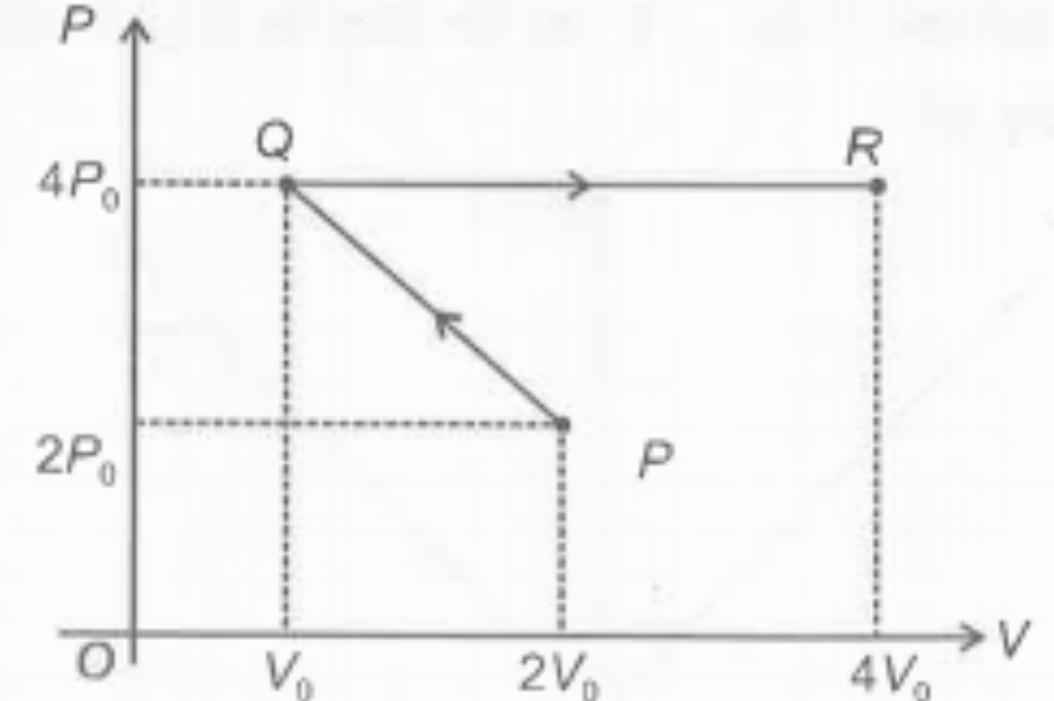An ideal gas is taken through a process in which the pressure and the volume are changed according to the equation p=kv. Show that the molar heat capacity of the gas for the process is given by (C=Cv+R2).
To solve the problem of finding the molar heat capacity C of an ideal gas undergoing a process defined by the equation p=kV, we will follow these steps:
Step 1: Use the Ideal Gas Equation
We start with the ideal gas equation:
pV=nRT
Substituting p=kV into the ideal gas equation gives:
kV⋅V=nRT
This simplifies to:
kV2=nRT
Step 2: Differentiate the Equation
Next, we differentiate both sides of the equation kV2=nRT with respect to time:
ddt(kV2)=ddt(nRT)
Using the product rule on the left side, we have:
k⋅2VdVdt=nRdTdt
This can be rearranged to express dV:
2kVdV=nRdT
Thus, we can express dV as:
dV=nR2kVdT
Step 3: Apply the First Law of Thermodynamics
According to the first law of thermodynamics:
dQ=dU+dW
Where dQ is the heat added, dU is the change in internal energy, and dW is the work done. We can express dQ as:
dQ=nCdT
And the change in internal energy dU for an ideal gas is given by:
dU=nCvdT
The work done dW can be expressed as:
dW=pdV
Step 4: Substitute dV and p
Substituting dV and p into the equation for dW:
dW=(kV)(nR2kVdT)=nR2dT
Step 5: Combine the Equations
Now we can substitute dU and dW back into the first law equation:
nCdT=nCvdT+nR2dT
Dividing through by ndT (assuming dT≠0):
C=Cv+R2
Conclusion
Thus, we have shown that the molar heat capacity C of the gas for the process is given by:
C=Cv+R2
We start with the ideal gas equation:
pV=nRT
Substituting p=kV into the ideal gas equation gives:
kV⋅V=nRT
This simplifies to:
kV2=nRT
Next, we differentiate both sides of the equation kV2=nRT with respect to time:
ddt(kV2)=ddt(nRT)
Using the product rule on the left side, we have:
k⋅2VdVdt=nRdTdt
This can be rearranged to express dV:
2kVdV=nRdT
Thus, we can express dV as:
dV=nR2kVdT
According to the first law of thermodynamics:
dQ=dU+dW
Where dQ is the heat added, dU is the change in internal energy, and dW is the work done. We can express dQ as:
dQ=nCdT
And the change in internal energy dU for an ideal gas is given by:
dU=nCvdT
The work done dW can be expressed as:
dW=pdV
Substituting dV and p into the equation for dW:
dW=(kV)(nR2kVdT)=nR2dT
Now we can substitute dU and dW back into the first law equation:
nCdT=nCvdT+nR2dT
Dividing through by ndT (assuming dT≠0):
C=Cv+R2
Thus, we have shown that the molar heat capacity C of the gas for the process is given by:
C=Cv+R2
Topper's Solved these Questions
Similar Questions
An ideal gas is taken through a process in which pressure and volume vary as P=kV2. Show that the molar heat capacity of the gas for the process is given by C=Cv+R3.
View SolutionFor a certain process, pressure of diatomic gas varies according to the relation P=aV2, where a is constant. What is the molar heat capacity of the gas for this process ?
View SolutionAn ideal gas (CpCv=γ) is taken through a process in which the pressure and volume vary as (p=aVb). Find the value of b for which the specific heat capacity in the process is zero.
View SolutionAn ideal gas (CpCv=γ) is taken through a process in which the pressure and volume vary as (p=aVb). Find the value of b for which the specific heat capacity in the process is zero.
View SolutionA monoatomic gas undergoes a process in which the pressure (P) and the volume (V) of the gas are related as PV−3=constant. What will be the molar heat capacity of gas for this process?
View SolutionAn ideal gas with adiabatic exponent γ=43 undergoes a process in which internal energy is related to volume as U=V2 . Then molar heat capacity of the gas for the process is :
View Solutionan ideal diatomic gas undergoes a polytropic process described by the equation P√V=constant . The molar heat capacity of the gas during this process is
View SolutionAn ideal gas (γ=1.5) undergoes a thermodynamic process in which the temperature and pressure of the gas are related as T−1P2= constant. The molar heat capacity of the gas during the process is
View SolutionIn a thermodynamic process on an ideal diatomic gas, work done by the gas is η times the heat supplied (η<1). The molar heat capacity of the gas for the process is
View SolutionAn ideal gas undergoes a process P→Q→R as shown in pressure (p) - volume (v) diagram.The work done by the gas is
 View Solution
View Solution

